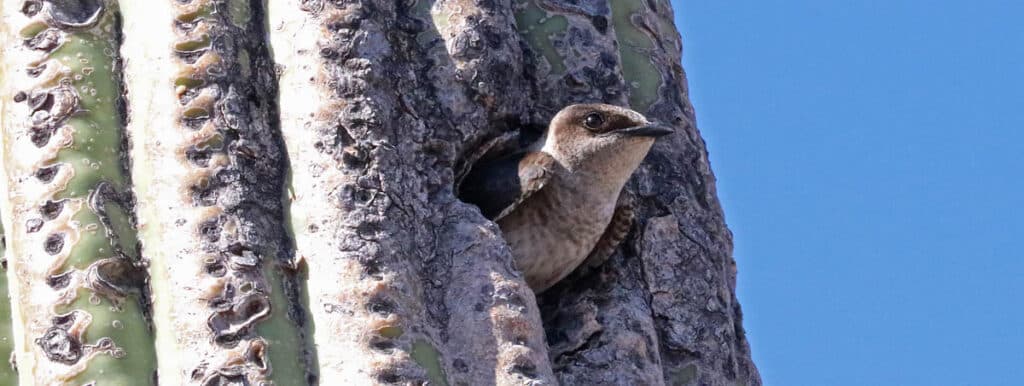Protect Birds & Their Habitats
Birding
Protect Birds & Their Habitats
Birding

Desert Purple Martins (Progne subis hesperia) are a subspecies of Purple Martins whose breeding range spans the southwestern United States and northwestern Mexico. They nest primarily in cavities created by woodpeckers in columnar cacti (saguaros and cardons). Availability of these nest cavities appears to limit their productivity and, by extension, total population size. Drought, coupled with invasion by non-native grasses into desert areas, has increased the frequency and intensity of cactus-killing wildfires. Saguaros can take 100-150 years to achieve the size necessary to host desert Purple Martin nests. Unlike their eastern counterpart, desert Purple Martins do not currently use nestboxes within their range, but they could benefit from a design that allows them to nest in artificial cavities as saguaro cactus face many current and ongoing threats leading to substantial losses in nest availability.
In an effort to provide additional nesting cavities for desert Purple Martins, we are opening a nationwide contest to solicit nestbox designs that would aid conservation of this imperiled sub-species. The goal is to use a biomimicry approach to design a nestbox that effectively replicates a saguaro cavity enhancing the chances that martins will adopt them. These nestboxes will provide shelter from harsh summer conditions in the Sonoran Desert. Our research shows temperatures in saguaro cavities, which are protected from outside conditions by inches of thick, water-storing flesh, may buffer ambient temperatures by 10 degrees F or more.
Please read through the requirements and suggestions to participate in this nestbox design challenge.
The contest submission window has now closed
Deadline: February 15th, 2023.
Design Guidelines:
Based on field measurements of saguaro cavities that Desert Martins have nested in, general Sonoran Desert conditions, and local ecological knowledge.


Left: Temperatures measured inside and outside of a saguaro cavity over a 3-day period in August 2022. Note how the cavity buffers ambient temperatures. Right: A “saguaro boot” is the internal structure of a saguaro cavity. Woodpeckers excavate the hole, then it scars over leaving a fully formed “boot” for birds to nest in.
Potential Considerations:
Things to consider that may or may not have relevance for replicating a cavity within a saguaro.
Designs will be evaluated by a panel of experts based on the following:
Prizes:
Cash prizes will be awarded after rating all designs based on the above criteria.
Each person or group can submit an unlimited number of designs.
Upload your detailed plan as a single file and include a list of materials, a sketch with dimensions, and indicate installation method. Finally, attach a paragraph describing the reasoning behind the design. Make sure file names include the name used on the submission form. For example: Purple_Martin_NB_plan_by_Joe_Smith.pdf.
For questions please contact Olya Weekley at oweekley@tucsonaudubon.org
This work is made possible through the Wildlife Conservation Society’s Climate Adaptation Fund, the Disney Conservation Fund, Arizona Game & Fish, and private donations.

Top photo by Henry T. McLin, contest graphic image by Francis Morgan, saguaro boot by Matt Griffiths, bottom by Richard Fray